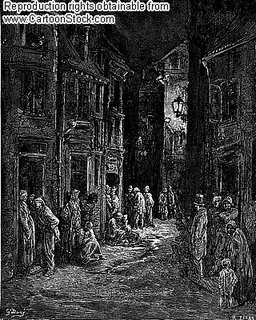
Sometimes you read something, in a book, newspaper or magazine, that makes you stop and think about it. It's a moment I actually enjoy that time when something connects with your brain and you think a little bit deeper than you may have normally done. But what about something that you read that not only makes you stop and think but actually mentally stuns you when you actually consider what it means? This is what happened to me a couple of weeks ago.
I was on the net at work looking for something to do with the London Borough of Southwark, on the site I was visiting there was a link which said 'want to know more about our history?' and after a couple of clicks I found myself on the home page of the Charles Booth Online Library.
Booth's study of London in 1898-99 is the seminal work on the economic condition of the cities inhabitants, streets are colour coded according to financial and social status from black at the bottom (lower class) through red (middle class) to yellow (upper middle and upper class) with colours in-between. The map was actually published in 1902 and was the result of many years work by Booth including walking the various beats of the East End between May 1897 and October 1900.
Between 1898 and 1901 my Dad's grandfather on his mother's side was living with his parents at a place called White Thorn Place in Wapping, East London. What Booth has (had) to say about the area they were living in only accounts for six and a bit lines in his great volume of notebooks but it's six and a bit lines that made me stop in my tracks. Here they are:
White Thorn Place, dark blue on the map, should be black. very rough. most windows broken. cockney irish. women sackmakers. 3 boys barefoot. cries of here's the school board & they promptly disappeared. children dirty, ragged but well fed. 3 storey houses. is bad and rough as anything in the sub-division.
This was where my great-grandfather and his two brothers and two sisters were living with their father and step-mother (old mother McDonald who I mentioned last year). Now if the conditions reported by Charles Booth aren't bad enough what you also have to bear in mind is that the family only moved there after there previous two houses were demolished as part of the 1875 Artisans and Labourers Improvement Act. Booth goes onto report that the surrounding streets are considered so rough that the police won't go down them after dark!
There are two points that fascinate me from a family history point of view: firstly, subsequent reading of Booth produced the fact that my Mum's grandfather on her mother's side was living and working as a farrier two streets away in an area described by Booth as middle class, where the wives don't have to work, but more importantly how my grandmother's side of the family made the social and economical leap from being the bottom of the pile at the turn of the 20th century to all being upper working class one hundred years (or three generations) later.
It is these small titbits of information that drive family historians on and it proves that it's not always how far back you go but how far forward you've come.
Incidentally, the drawing at the top of the post is called Shadwell Slums which is relevant because the area where my ancestors were living is sometimes described as Shadwell and sometimes as Wapping.
1 comment:
The online stuff at Booth's is a must for anyone who has ancestry in London as I discovered some years ago. It all makes for fascinating reading especially the reports on individual houses sometimes and not just streets or localities. It does, as you say, put flesh on the bones and really makes you understand what bloody hard lives most had.
I sometimes wonder how anyone of them survived for long enough and then had the energy to pro-create!
Parts of my family originated from the Black Country proper as I would call it and not just the periphery where I was born. They led hard lives as chain makers, nail makers and the like and some lived in a part of what is now Dudley, where life expectancy in 1881 was a mere 17 years and a couple of months!
Reading Booth helped me understand a lot more than just the life of Londoners although I was able to apply it as you have done, to another branch of my family. They would have been better off staying in Tamworth but that's another story!
Post a Comment